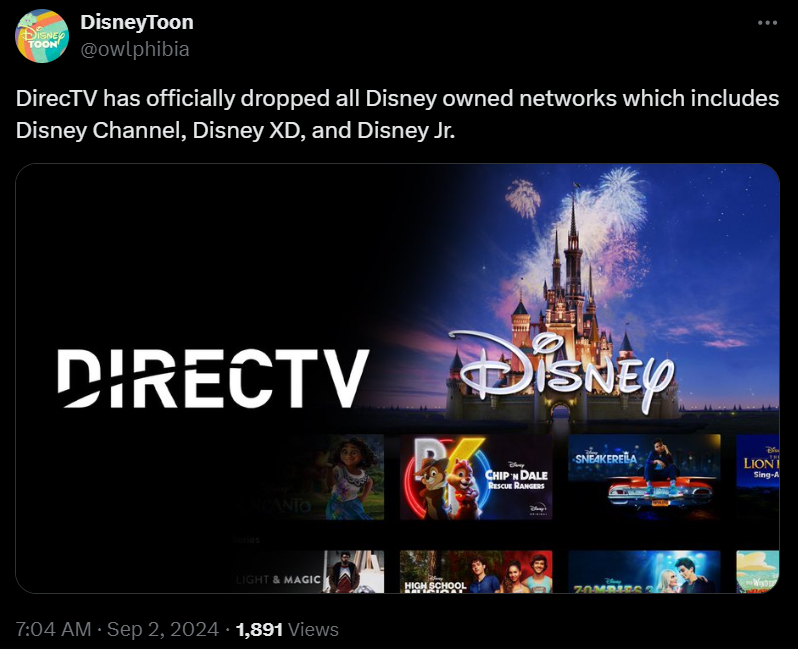The newest argued between Disney and DirecTV has left millions of customers in the dark, as Disney Cuts Off ESPN and the expiration of their distribution deal has resulted in a substantial blackout of Disney-owned channels. This disruption occurs at an especially unpleasant moment, with the college football season in full gear, the US Open nearing its end, and the NFL season just around the corner.
The disagreement, which concerns Disney’s huge portfolio of networks such as ABC, ESPN, FX, National Geographic, and Freeform, has made these channels unavailable to DirecTV’s over 11 million satellite subscribers. The blackout occurred on Sunday, immediately before a highly anticipated college football game between the USC Trojans and the LSU Tigers, and coincided with a critical portion of the US Open tennis event

The discussion over carriage fees, which cable and satellite providers pay media corporations to distribute their programs, is central to this conflict. DirecTV has accused Disney of charging unduly high fees, which DirecTV has vigorously denied. Rob Thun, DirecTV’s Chief Content Officer, has attacked Disney for pursuing greatest profit at the expense of consumers.
Thun claims that Disney’s emphasis on bundling its channels and charging exorbitant fees is detrimental to viewers, who are left with less options and greater expenditures. In response, Disney stated that its fee requests are consistent with industry standards and represent the value of its networks.
Disney’s entertainment executives, including Dana Walden, Alan Bergman and ESPN Chairman Jimmy Pitaro have asked DirecTV to agree to terms that would restore the service. They say that Disney’s channels provide significant value, and that DirecTV’s failure to satisfy their criteria deprives millions of subscribers of their preferred entertainment.
Disney Cuts Off ESPN, ABC, and More in Contract Dispute
This is not the first time Disney has clashed with a big distributor. Last year, Disney and Charter Communications, Spectrum’s parent firm, had a similar stalemate. The argument, which lasted from late August to just before the start of the NFL season, resulted in a short Disney channel blackout for Charter subscribers. The matter was eventually resolved when Charter agreed to an agreement that included access to Disney’s streaming services, but not without some viewer displeasure.
The latest fight with DirecTV is similar to the prior one, but with added complexities. DirecTV has developed a website, UnbundleDisney.com, to expose what it believes are Disney’s excessive bundling practices. The website criticizes Disney’s technique of connecting numerous networks and requests that Disney provide more flexible and consumer-friendly solutions.
The impact of the Disney-DirecTV disagreement goes beyond the immediate discomfort for subscribers. It highlights ongoing tensions in the media and entertainment industries, particularly as traditional cable and satellite providers deal with the emergence of streaming services. DirecTV, once a major player with a peak of 21 million subscribers, has dropped to under 9 million. This reduction reflects a broader trend of cord-cutting, in which customers increasingly rely on streaming platforms for entertainment.
The broader media environment is altering as major businesses such as Disney, Warner Bros. Discovery, and Paramount focus increasingly on streaming services. Disney, for example, has aggressively expanded its direct-to-consumer offerings, which include Disney+, Hulu, and ESPN+.These changes are part of a larger strategic movement away from traditional cable bundles and toward more adaptable and adjustable streaming options.

Jonathan Alcorn/Reuters
DirecTV’s Thun recently expressed unhappiness with the slow progress in negotiating more personalized bundles. He suggested that present bundling techniques imposed by programmers such as Disney are out of date and do not reflect changing consumer preferences. DirecTV has advocated for smaller, less costly bundles adapted to modern watching patterns, which contrasts with Disney’s strategy of keeping complete, packaged services. Both parties face significant financial risks.
Disney’s demands for higher carriage fees are part of a larger drive to generate significant revenue through distribution agreements. The media company has maintained that its channels, which include ESPN and ABC, add significant value and deserve greater payments.DirecTV, on the other hand, has described these demands as excessive, especially given the changing landscape in which streaming services provide other watching options at similar prices.
The earlier agreement between Disney and Charter Communications, which was reached only hours before a vital Monday Night Football game, was believed to include Disney receiving $2.2 billion in fees from Charter. This agreement also allowed Charter users to access Disney’s streaming services, highlighting an increasing trend of traditional cable providers including streaming choices into their offers.
The blackout has an immediate impact on customers by preventing them from accessing popular programming and sporting events. This disturbance is most noticeable during peak sports seasons, when viewers rely on networks such as ESPN for live coverage. The timing of the blackout has exacerbated audience unhappiness because it overlaps with key events such as college football games and the end of the US Open.
Also read: India Breaks Down On Telegram For Violating Content Rules [2024]
Looking ahead, it seems likely that this conflict will be resolved through some type of compromise. Historically, such standoffs have been resolved by renewing agreements that accommodate both parties’ concerns. However, with the media landscape fast changing and the shift to streaming gaining traction, the terms of any new agreement must reflect these developments.
The protracted debate highlights the broader issues that traditional media companies face as they navigate a landscape increasingly dominated by digital and streaming services. As Disney and DirecTV continue to negotiate, the conclusion will be eagerly followed by industry analysts and customers alike.
